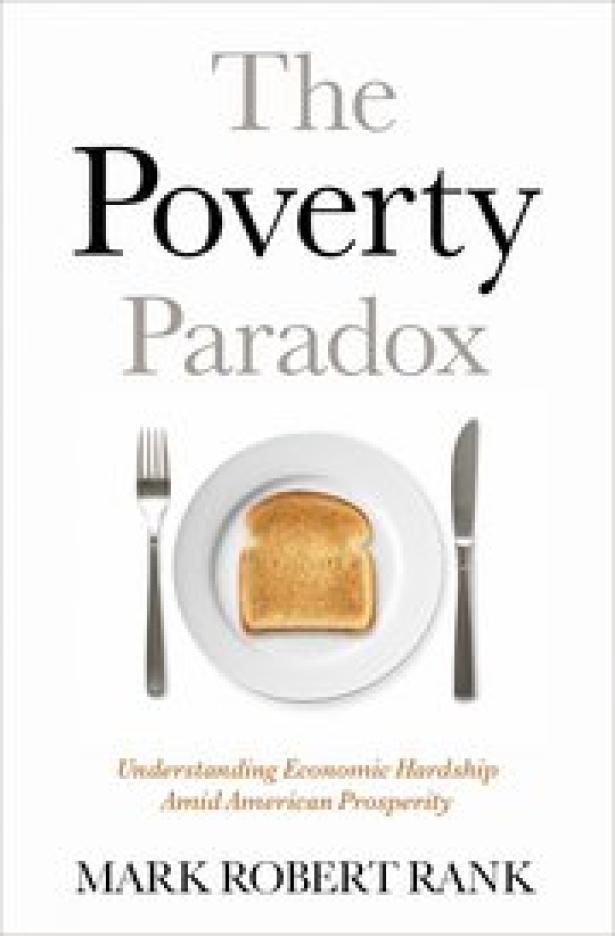books The Poverty Paradox: Understanding Economic Hardship Amid American Prosperity
The Poverty Paradox
Understanding Economic Hardship Amid American Prosperity
Mark Robert Rank
Oxford University Press
ISBN: 9780190212636
Mark Robert Rank’s ambitious book, The Poverty Paradox, is said to be “a game changing examination of poverty and inequality. It provides the essential blueprint for finally combatting this economic injustice in the years ahead.”
Rank advocates for a fundamental change to our perspective on poverty. “The traditional perspective” on poverty, he writes, is that “the vast majority of the poor are responsible for their economic circumstances” and as a consequence “government assistance should be kept to a minimum, with strong work incentives emphasized.” He argues that the perspective of blaming poverty on the failures of the poor is a “major reason for historically high rates of poverty” in the U.S., and it is the reason America’s poverty programs “have been ineffective or minimal.” The right perspective, argues Rank, “is that poverty ultimately results from failures at the economic and political levels,” not personal failures of the poor themselves. He coins the term “structural vulnerability explanation of poverty” to explain why individuals cannot lift themselves out of poverty.
The author begins with a helpful primer on alternative ways to define and measure poverty. Rank sums up the recent results by writing that “For 2021, 11.6% of the population fell below the official poverty line, representing 37.9 million individuals; 19.4% experienced poverty or near poverty; and 5.5% were living in extreme poverty.”
His primer also offers insights on factors that drive differences in poverty rates. Rank points to the demographic traits such as race, gender and household structure associated with significant differences in poverty rates. For example, the poverty rate for whites (not of Hispanic origin) was 8.1% as compared to 19.5% for Blacks. For households led by married couples, the poverty rate was 5.2%; for households led by single females the poverty rate was 25.3%.
Referring to differences in “Human Capital,” Rank points to education and work experience. The poverty rate for those with less than 12 years of education was 27.2%, while that for those with 12 years of education was much lower at 13.2%; for those with 16 or more years of education the poverty rate was just 4.1%. In terms of work experience, the poverty rate for those who worked part-time was 12.2% while for those who worked full-time the rate was just 1.8%.
The reader can see how these results could support the traditional perspective about individual responsibility for falling into poverty. For example, Rank cites a quote from another top poverty expert, Isabel Sawhill at Brookings, on what it takes to stay out of poverty. Sawhill writes “The challenge is to find ways of providing generous support to the poor without disregarding the unpleasant facts about their behavior. Ideally, we need to nudge them toward a different set of behaviors by linking generous government assistance to staying in school, delaying childbearing, getting married, and working full-time.”
In contrast, however, Rank argues that these poverty rates reflect America’s “minimalist” approach to its poverty programs: “Contrary to the popular rhetoric of vast amounts of tax dollars being spent on public assistance, the American welfare state, and particularly its social safety net, can be more accurately described in minimalist terms. Compared to other Western industrialized countries, the United States devotes far fewer resources to programs aimed at assisting the economically vulnerable.”
As to evidence to this point, Rank reports the results of his companion of Pretax/Transfer and Posttax/Transfer poverty rates in 21 Organization for Economic Cooperation and Development (OECD) countries including the United States. Rank’s argument is that the other OECD countries do a great deal more to reduce the poverty rate.
Specifically, on average the OECD countries excluding the United States reduced their Pretax/Transfer poverty rates from 29.3% to 9.7%—that is, they reduced the poverty rate by 66.9%. In contrast, the United States had a Pretax/Transfer poverty rate in the ballpark of the OECD average (it was 26.8%), but the United States reduced that poverty rate by only 33.6%. Readers will want to draw out the implications of Rank using a different definition of the poverty line here.
In terms of an economic blueprint for combatting poverty, the book gives a broad view and much of it will not be new to the reader. Rank calls for greater access to “public resources” including education, healthcare, and housing. In terms of specific proposals, Rank calls for a significant increase in the federal minimum wage and the earned income tax credit. He also calls for grass-roots advocacy and labor unions to reduce inequality. Given his expertise, the reader might expect more specific, innovative policy proposals.
Perhaps Rank is right; we may need a new view of American poverty programs. The new view must reflect the fact that we need all hands on deck to fight looming, global economic battles, and those battling for America must all be highly skilled. In that context, to borrow an iconic phrase, a mind is a terrible thing to waste, and innovative education and training must be an essential part of our effort to reduce poverty.
Craig R. Roach is an author of narrative nonfiction. His book Simply Electrifying: The Technology that Transformed the World, from Benjamin Franklin to Elon Musk (BenBella Books, 2017) won a 2018 Axiom Business Book Award Gold Medal.


Spread the word